|
Posted: July 23, 2003
By Jon Dougherty
© 2003 WorldNetDaily.com
With the launch of its own domestically
produced warships comparable to American Aegis-equipped
vessels, China is angling for control of the regional
high seas and challenging U.S. power in the area,
analysts and reports indicate.
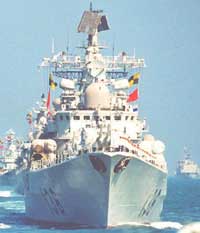 |
| Chinese Warship |
According to a May report in the Hong
Kong Tai Yang Bao newspaper, the new warship – a
destroyer – was launched earlier this summer and
represents China's first next-generation vessel built at
home. As WorldNetDaily reported, the People's Liberation
Army Navy, or PLAN, has been purchasing Russian-built
Sovremenny-class destroyers to upgrade its "brown
water," mostly coastal-defense navy to a long-range
blue-water fleet.
An analysis of the warship, published by the American
Foreign Policy Council, or AFPC, said it will be
equipped with an advanced radar system, stealth design,
a vertical launch system and long-range anti-aircraft
missiles, the latter to "fill in for the Chinese navy's
gaps in launching seaborne long- and medium-range
anti-aircraft attacks."
The United States was the first to deploy the Aegis
Combat System. Developed for the Navy, the system "was
designed as a total weapon system, from detection to
kill," according to the Navy's description of the
technology.
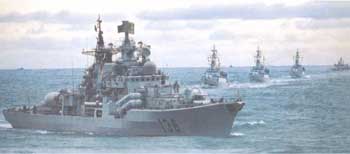 "The
heart of the system is an advanced, automatic detect and
track, multi-function phased-array radar, the AN/SPY-1.
This high powered (four megawatt) radar is able to
perform search, track and missile guidance functions
simultaneously with a track capacity of over 100
targets," the Navy says. Aegis was first tested on the
USS Norton Sound, a sea plane reconnaissance ship, in
1973. "The
heart of the system is an advanced, automatic detect and
track, multi-function phased-array radar, the AN/SPY-1.
This high powered (four megawatt) radar is able to
perform search, track and missile guidance functions
simultaneously with a track capacity of over 100
targets," the Navy says. Aegis was first tested on the
USS Norton Sound, a sea plane reconnaissance ship, in
1973.
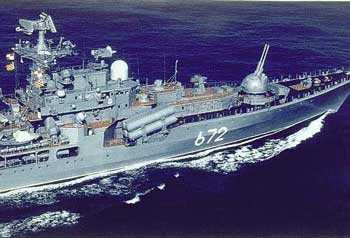 AFPC
said China's new class of "Aegis" ships will likely be
integrated first into the PLAN's South Sea Fleet within
three to five years. The domestically produced ships may
not be fully operational before 2005 "because
verification of the destroyers' current computer
integrated technology capability – specifically the
ability to process a huge amount of signals needed to
meet the needs of the phased-array radar systems – has
yet to be completed," said the policy center. AFPC
said China's new class of "Aegis" ships will likely be
integrated first into the PLAN's South Sea Fleet within
three to five years. The domestically produced ships may
not be fully operational before 2005 "because
verification of the destroyers' current computer
integrated technology capability – specifically the
ability to process a huge amount of signals needed to
meet the needs of the phased-array radar systems – has
yet to be completed," said the policy center.
Analysts at the center said the
capabilities of the warship mean China has made great
strides in shipbuilding technologies over the past two
decades as the PLAN moves toward long-range power
projection, most likely as a hedge against U.S. naval
reach and power.
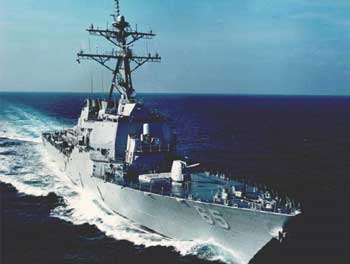 |
| U.S.
Aegis-Class Arleigh Burke |
Aegis Combat Systems were first tested
on U.S. warships in 1973 and installed on Spruance- and
Arleigh Burke-class destroyers, the latter like the
vessel pictured above. China
rival Taiwan has repeatedly requested the U.S. sell it
Aegis-equipped warships, but so far Washington has
refused. WorldNetDaily reported in 2001 the island
democracy has even offered to build Aegis-equipped
warships locally, but only if the U.S. agreed to
transfer the technology. The latter demand was a deal
breaker, however.
In June, a 59-member panel of the Council on Foreign
Relations released a report concluding "the Chinese
military is at least two decades behind the United
States in terms of military technology and capability."
The report went on to say if the U.S. continued its
current level of investment in the military, Washington
should retain its 20-year technical and technological
advantage over Beijing.
But Richard Fisher, a senior fellow and China analyst at
the Jamestown Foundation – while generally praising the
CFR's effort – pointed out current weapons systems being
developed by China could negate much of the U.S.
technical advantage.
For example, one area "in which the CFR does not give
full weight to the capability-accelerating potential of
foreign technology is in PLA space warfare plans,"
Fisher says in an analysis of panel's report. He also
said a new solid-fuel space launch vehicle, or SLV,
based on the DF-21 medium-range ballistic missile
(below) and the DF-31 intercontinental ballistic
missile, is being developed to launch anti-satellite
interceptors, as WorldNetDaily has previously reported.
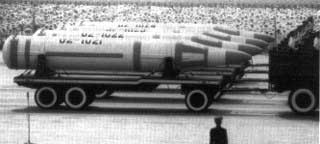 |
| Chinese DF-21
Missile (above) and DF-31 (below) |
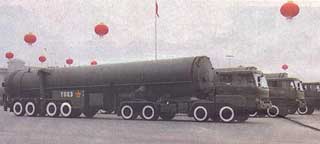 |
The Chinese also are developing the DF-31A, which has
yet to be deployed.
"The ability of these SLVs to launch ASAT interceptors
was accelerated by a 1998 contract to develop a new
generation of micro-satellites signed by China's
Tsinghua University and Britain's Surrey Space Systems.
This technology will accelerate the PLA's ability to
develop satellite interceptors" and, if deployed against
U.S. satellites, "a 20-year technical advantage would be
rapidly diminished," Fisher wrote.
China military analysts also say Beijing's modernization
effort is still progressing despite European and
American weapons embargoes. China, for instance, has
obtained and still does obtain dual-use technologies
from U.S. and European firms – technology which,
ultimately, is incorporated into various military
programs.
And Russia is helping to modernize China's military
machine. As WorldNetDaily has reported, Moscow – in need
of capital to modernize its own military – is helping
Beijing to attain superpower status.
The Hong Kong Sunday Morning Post reported June 8 that
"a new colossus may be forming in the east as Russia and
China edge toward a symbiotic relationship that could
create the world's next economic, military and
space-faring superpower."
"Relations with China constitute the most important
factor in Russian foreign-policy strategy," says Gennady
Chuffrin, deputy director of Russia's Institute for
World Economy and International Relations.
Beijing and Moscow signed a deal to build a $2.5 billion
oil pipeline from Siberia to the Chinese industrial
center of Daqing, which is also the location of China's
oldest oil fields. That deal also commits China to
purchase $150 billion worth of Russian crude oil over 25
years.
Capital is also key to Chinese military modernization,
analysts say, and a great deal of those funds come from
a vast and expanding trade deficit with the United
States. Of the estimated $400 billion annual deficit,
$100 billion is with China.
Perhaps sensing the country's inability to compete
militarily with the world's other great powers, Chinese
leaders have increasingly called for making military
modernization a priority.
"New technologies, particularly information technology,
have seen spectacular advances that are fueling the
evolution of the world's armed forces," said Jiang Zemin,
head of the powerful Central Military Committee. "Our
military faces a formidable challenge but should not
miss out on the opportunity to modernize and prepare for
combat."
Agence France-Presse reports that Jiang, since early
June, has been urging the 2.5-million strong armed
forces to recruit more qualified personnel and join the
information age.
|